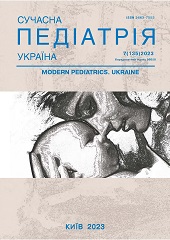State of diagnostic markers of inherited metabolic diseases in newborn: analysis of previous results of neonatal screening in Ukraine
DOI:
https://doi.org/10.15574/SP.2023.135.16Keywords:
extended neonatal screening, inherited metabolic diseases, premature babiesAbstract
Despite the different number of inherited metabolic diseases (HMDs) in the panel of expanded neonatal screening (ENS), each country has its own reference values of diagnostic analytes for HMDs specific to its population. In Ukraine, unfortunately, there are no such reference intervals of marker indicators that are responsible for the realization of certain metabolic disorders.
Purpose - to analyse the diagnostic markers of SCD and determine the trend of these indicators for the Ukrainian pediatric population.
Materials and methods. Therefore, the article presents the previous results of the ENS with the determination of the trend of laboratory indicators of HMDs specifically for the Ukrainian population of newborn children. During the period of the study, ENS by tandem mass spectrometry was performed for 165 newborns born at the SI «Institute of Pediatrics, Obstetrics and Gynecology named after academician O.M. Lukyanova of the NAMS of Ukraine» during 2020-2022.
Results. When analyzing the obtained data, a non-linear correlation dependence of the level of diagnostic analytes, namely long-chain fatty acids, depending on the body weight at birth was noted: in groups of children with low and very low body weight at birth, the average values of indicators C0/(C16+C18); (C14:1/C16); (C18:1/C16); (C18:2/C16) are significantly higher compared to children with satisfactory birth weight.
Conclusions. Analytical considerations for the interpretation of ENS results include both the influence of maternal conditions during pregnancy and the influence of factors from the side of the newborn. Positive results of ENS require differential diagnosis between perinatal and hereditary diseases, a number of clarifying studies, and further follow-up.
The research was carried out in accordance with the principles of the Helsinki Declaration. The study protocol was approved by the Local Ethics Committee of the participating institution. The informed consent of the patient was obtained for conducting the studies.
No conflict of interests was declared by the authors.
References
Asghar A, Shabanova V, Mercurio MR et al. (2019). A high rate of false positive newborn screening results in the neonatal intensive care unit. J Child Adolesc Health. 3 (1): 7-11.
Chien YH, Hwu WL. (2023, Feb). The modern face of newborn screening. Pediatr Neonatol. 64; Suppl 1: S22-S29. https://doi.org/10.1016/j.pedneo.2022.11.001; PMid:36481189
Knapkova M, Hall K, Loeber G. (2018). Reliability of neonatal screening results. Int J Neonatal Screen. 4: 28. https://doi.org/10.3390/ijns4030028; PMid:33072949 PMCid:PMC7510242
Lim MD. (2018). Dried blood spots for Global Health diagnostics and surveillance opportunities and challenges. Am J Trop Med Hyg. 99: 256-265. https://doi.org/10.4269/ajtmh.17-0889; PMid:29968557 PMCid:PMC6090344
MOZ Ukrainy. (2021). Poriadok provedennia rozshyrenoho neonatalnoho skryninhu. Nakaz Ministerstva okhorony zdorov'ia Ukrainy vid 01 zhovtnia 2021 roku No. 2142.
Pearce M, DeMartino L, McMahon R et al. (2016). Newborn screening for congenital adrenal hyperplasia in New York State. Mol Genet Metab Rep. 7: 1-7. https://doi.org/10.1016/j.ymgmr.2016.02.005; PMid:27331001 PMCid:PMC4908061
Sontag MK, Miller JI, McKasson S et al. (2020). Newborn screening time-liness quality improvement initiative: impact of national recommendations and data repository. PLoS One. 15: e0231050. https://doi.org/10.1371/journal.pone.0231050; PMid:32240266 PMCid:PMC7117765
Vats P, Dabas A, Jain V et al. (2020). Newborn screening and diagnosis of infants with congenital adrenal hyperplasia. Indian Pediatr. 57: 49-55. https://doi.org/10.1007/s13312-020-1703-3; PMid:31937698
Znamenska TK, Vorobiova OV, Kuznetsov IE, Holota TV, Kryvosheieva VV, Kremezna AV ta in. (2020). Optymizatsiya diahnostyky spadkovykh khvorob obminu rechovyn pry pozytyvnykh rezul'tatakh rozshyrenoho neonatal'noho skryninhu. Neonatolohiya, khirurhiya ta perynatal'na medytsyna. 2 (36): 19-28. https://doi.org/10.24061/2413-4260.X.2.36.2020.2
Znamenska TK, Vorobiova OV, Kuznetsov IE, Holota TV, Kryvosheieva VV, Kremezna AV ta in. (2021). Osoblyvosti rozshyrenoho skryninhu na spadkovi khvoroby obminu rechovyn u peredchasno narodzhenykh. Neonatolohiia, khirurhiia ta perynatalna medytsyna. 11 (3,41): 5-16. https://doi.org/10.24061/2413-4260.XI.3.41.2021.1
Downloads
Published
Issue
Section
License
Copyright (c) 2023 Modern pediatrics. Ukraine

This work is licensed under a Creative Commons Attribution-NonCommercial 4.0 International License.
The policy of the Journal “MODERN PEDIATRICS. UKRAINE” is compatible with the vast majority of funders' of open access and self-archiving policies. The journal provides immediate open access route being convinced that everyone – not only scientists - can benefit from research results, and publishes articles exclusively under open access distribution, with a Creative Commons Attribution-Noncommercial 4.0 international license (СС BY-NC).
Authors transfer the copyright to the Journal “MODERN PEDIATRICS. UKRAINE” when the manuscript is accepted for publication. Authors declare that this manuscript has not been published nor is under simultaneous consideration for publication elsewhere. After publication, the articles become freely available on-line to the public.
Readers have the right to use, distribute, and reproduce articles in any medium, provided the articles and the journal are properly cited.
The use of published materials for commercial purposes is strongly prohibited.

